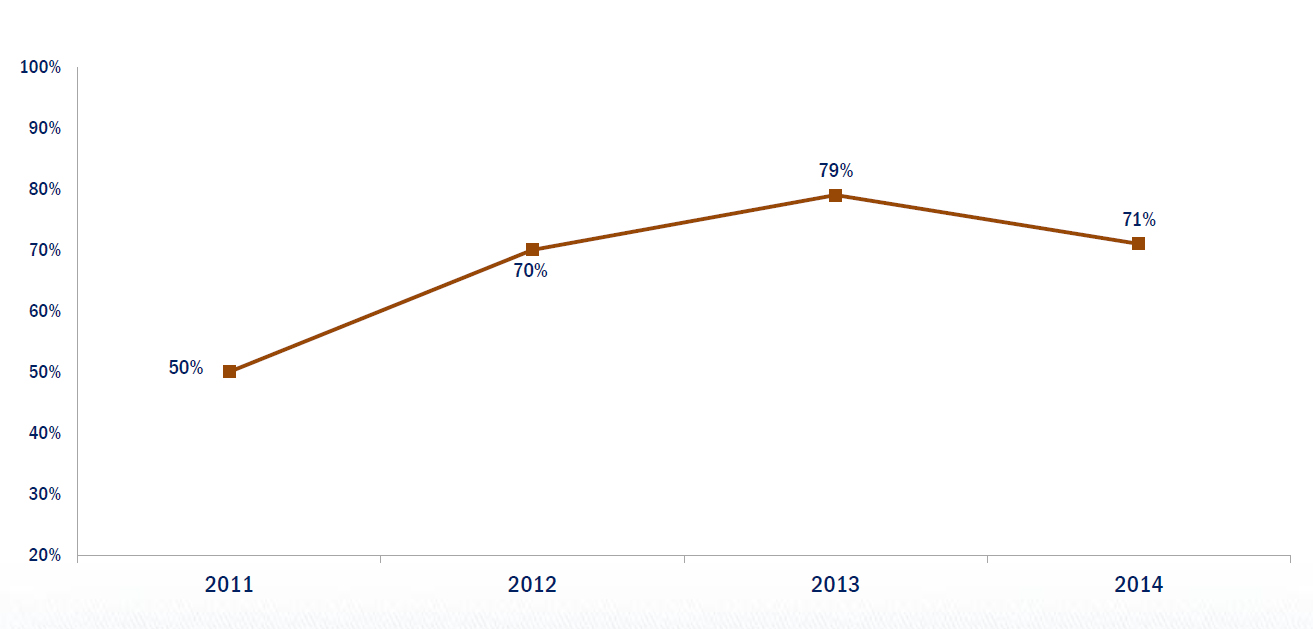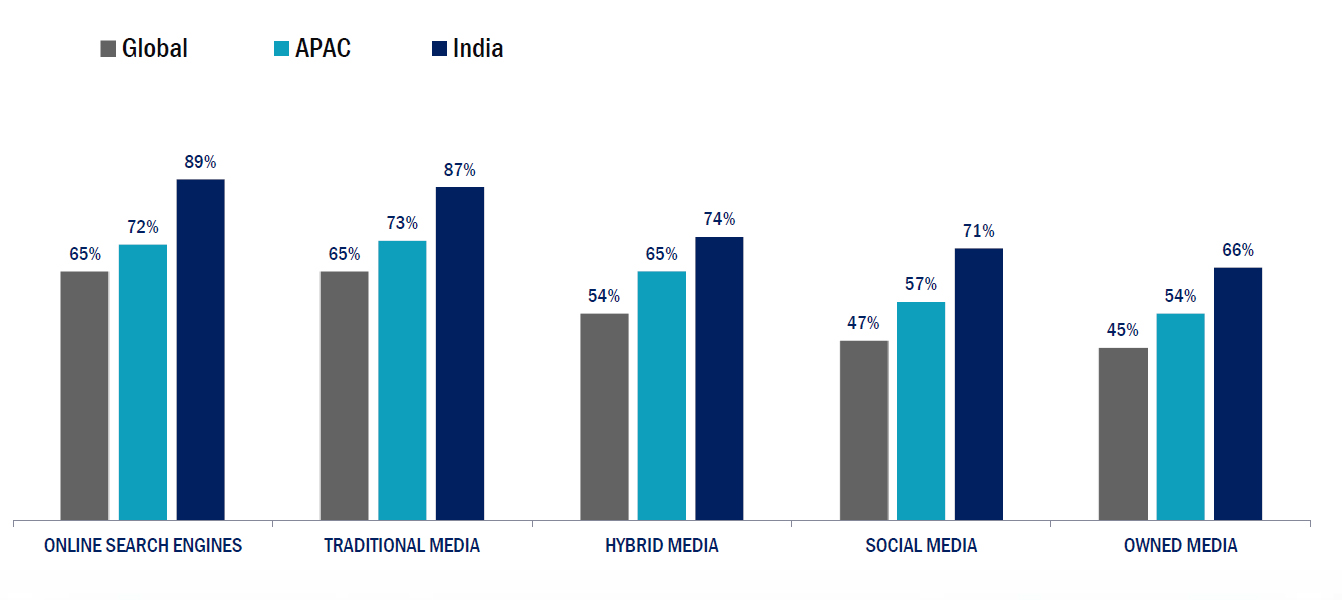If trust in the media is falling – why did Modi win by a landslide?
PR Insight
Paarul Chand
Earlier this year, the Edelman Trust Barometer for 2014 found that, as compared to 2013, trust in the media in India has slipped from 79% to 71% in 2014.

SOURCE: Edleman Trust Barometer
In May 2014, NGO Freedom House put out a report titled Freedom of Press 2014. The report showed that media trust in India had declined. India was ranked a low 78 among a list of countries for press freedom. The report says that, “India's score declined by a point, to 39, to reflect increased interference in content by media owners in the run-up to the 2014 elections, which led to the dismissal of key editorial staff in several instances.”
This led us to explore the issue further and find out whether trust in the media has indeed declined in India and what that means for the PR business.
Many would say that the results of the recent elections which headlined Modi led reportage – a lot of it in his favour – shows that people still trust the media. Or they wouldn’t have voted overwhelmingly for Modi. But that still leaves the issues of editorial independence, free space to dissent and media neutrality to consider.
Media trust and owner interference
According to Hartosh Singh Bal, political editor of Caravan magazine: “The interference of owners in editorial has a long history and the Congress has consistently used this fact to its advantage, using owners to influence editorial policy in their favour. Modi has built upon this and almost perfected the process. The mainstream media has reached the stage that judging by the editorial line of most organisations he can do no wrong. It is one thing for a newspaper to have an ideological line, in which case a right wing newspaper might support 80 percent of Modi's initiatives, but would oppose them 20 percent of the time. But in the current environment Modi is projected as being right 100 percent of the time – that is not a thought out editorial position that is the media succumbing to a personality cult.“
Hartosh Singh Bal had left Open magazine after differences with the owner and has since taken the matter to labour court under the Working Journalist Act arguing that the contract system cannot supplant this act. The case is still pending at court.
Nitin Mantri, CEO and Business Partner at Avian Media says that media trust has definitely declined. Nitin feels that, “Gone are the days when whatever the media wrote or said was gospel truth. Sensationalism and Fox TV-kind of television journalism has dented the credibility of journalism. Also, there is a growing tendency among some media houses to be in consensus and fall in line with the government’s official view on critical matters. The Indian government has also been under fire in recent years for its clampdown on social media. In 2012, the government sought to block the Twitter accounts of some prominent journalists and news organisations, arguing the content was stoking communal tensions. While responsible journalism is important, is a clampdown the best way of doing that?”
Nitin agrees that, “Press freedom has also deteriorated due to increased interference by media owners. Open magazine, CNN-IBN are among some of the leading media houses where we have seen and will see prominent journalists moving on due to owner-driven pressures.”
Nitin points out that, “We all know that the media in India does not just reportage, it shapes opinions and is definitely a player in Indian politics and elections. Sadly, this election coverage has only been about individuals. The debates on television and newspaper articles just concentrated on Narendra Modi, Rahul Gandhi and Arvind Kejriwal. There was hardly any focus on issues at the ground level. “
Nitin adds, “While urban India can sieve through the information overload, what is worrisome is that television reaches out to those who cannot read and write. Hence, when the dissemination of information is not free and fair, how can we expect the people in remote, backward areas to make the right choice while choosing a leader? There may be hundreds of news channels, but it is definitely at the cost of accuracy and ethics.“
Ways to bring media credibility back
Hartosh feels that the kind of media ownership is a core issue. Hartosh says, “Several countries in the world have guidelines and regulations on who can own the media. We should have similar guidelines in India. Media cannot be treated as just any other business. Tomorrow if a steel factory owner sets up a magazine and he doesn’t get an additional plant approved by the Government – suddenly you will find the editorial line changing. These issues need to be tackled.”
Another issue is the current hire and fire nature of journalism. Hartosh says, “You can’t expect individual journalists’ to take a stand against the owner. Not everyone can quit if he has a difference of opinion with the owner. The point is that we need to protect the rights of individual journalists – if they have just about as much protection as a retail manager then the consequences will be that we will get the media we deserve. The Working Journalist Act, which was meant to protect the rights of journalists, has been supplanted by the contract system. Currently the hire and fire system for journalists’ rules. There is a Parliamentary Standing Committee on journalism for contract work that is currently looking at these issues and its recommendations need to be looked at.”
The future of journalism depends on several factors which includes protection of individual journalists, looking at the question of the financing of the media business and transparency of the financials of a media house-newspaper or television. According to a recent Standing Committee report on paid news (2013) the Committee, “Identified corporatisation of media, desegregation of ownership and editorial roles, decline in autonomy of editors/journalists due to emergence of contract system and poor wage levels of journalists as key reasons for the rise in the incidence of paid news. The Committee urged the MoIB to ensure periodic review of the editor/journalist autonomy and wage conditions.”
Declaring Ownership Patterns
Should media companies declare ownership patterns? Nitin firmly says, “Yes, I think they should. In fact HT-Mint follow disclosure norms when there are stories related to cross media holdings of the publishers. However, it’s not about holding patterns in newspapers. The owners’ business interests need to be disclosed. For example, if a publisher has business interests in another company, when that company is covered, there should be full disclosure. That isn’t expecting too much is it?”
Hartosh too believes that, “The entire financial information about a media organisation – where the finance comes from, who are their advertisers, their balance statements, what salaries they pay the journalist – should all be publicly published. If it’s not, this information should be accessible through RTI.”
The other side of the story
Many journalists believe that media trust has not declined. Gopal Sathe, journalist says, “I still see a lot of people who staunchly defend views and opinions simply because they have read it in the newspaper, or seen it on television. I do believe however, that thanks to social media and blogs, the vocal minority of people who have never trusted the media are far more visible. I personally believe that people turn to social media and the Internet to share their negative experiences – positives are rarely reported without a lot of prompting. Therefore, you'll find most of the criticism – which may or may not have merit – while most of the trust and support stays hidden.”
Gopal added, “The election coverage amplified the reader response – both positive and negative. What some people would have felt only mildly is now being expressed strongly. This applies to both positive and negative sentiment.”
Modi ran the most visible and consistent campaign using both the mass media and social media – according to Piyush Pandey, Executive Chairman of Ogilvy and Mather (one of the two architects of the Modi poll campaign), they were producing as many as 125 artworks and 10 films every day. The results of such a high profile and a high decibel are clear to see, demonstrating that people do trust the media and the messages it carries. Media in India not only was the medium for the ads but also consistently headlined Modi in stories – his actions often setting the news agenda of the day.
This is borne out by the fact that in spite of the decline in media trust, The Edelman Trust Barometer also shows that India still shows greater trust in traditional and social media than other countries.
Trust in traditional media and social media is more in India than globally:

SOURCE: Edelman Trust Barometer
How does decline in media trust impact PR?
Nitin feels that the media landscape has changed and newspapers are not the holy cows that they used to be. “The digital boom has changed media dynamics and dictates the way the PR industry devises communication plans for clients. Industry professionals are even saying that the press release is dead. In India, we still haven’t got there, but yes, event or product announcements can be made on social media platforms, which have a wider audience and are more interactive. Social media is also influencing traditional media and a lots of trends get picked up from there, and in fact when it comes to credibility, social media channels win hands down. The Nirbhaya case is a good example where it was the social media that took up the cause forcing TV channels to follow. So, we can safely say the PR industry’s job has evolved and become more sophisticated. At the same time, regional media continues to grow as social media reach is still limited.”
Nitin says, “This has created greater opportunity for high quality brand journalism. PR agencies are aiming to show their clients as thought leaders. This allows a company to have its name published without waiting for it to be mentioned in a newspaper article. So, high-quality branded content is certainly the buzzword now. “
As the Modi PR drive carries on through the next few weeks of cabinet formation and policy making, it remains to be seen whether the Modi will maintain its true role of being an objective watchdog rather than a cheerleader.
Written by Paarul Chand
If you enjoyed this article, you can subscribe for free to our weekly event and subscriber alerts.
Featured

PR professionals share their views on journalists publicly calling them out on story pitches

Auto blogger renders unconditional apology to Value 360 for defamatory posts

Hottest Indian startups of 2020, Paytm, Dreams 11 lead the charge: Wizikey Report




